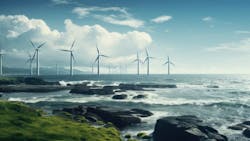Offshore wind developers debating potential success of planned projects
Editor's note: A condensed version of this story first appeared in the 2023 Offshore Wind Special Report, which published within the September/October 2023 issue of Offshore magazine.
By Jeremy Beckman, Editor, Europe
Soaring costs, construction setbacks and bureaucracy are among the many issues causing offshore wind developers to openly question the viability of planned projects.
Danish renewable energy major Ørsted warned recently of setbacks to its US East Coast Ocean Wind 1, Revolution Wind and Sunrise Wind developments, all hampered by supplier delays and rising interest rates, and slow progress in talks with senior federal stakeholders on expanding Investment Tax Credit qualifications for two of the projects. In the worst case, this could lead to collective impairment charges of up to DKK11 billion ($1.58 billion), although the company stressed it was still aiming to take final investment decision (FID) on the projects by early 2024.
Equinor and partner bp are reportedly seeking enhanced offshore renewable energy credits compared with the terms originally agreed for their Empire Wind 1 and 2 and Beacon Wind farms offshore New York, with a combined capacity of 3,300 MW. They claim that multiple factors have pushed up the project costs, including inflation, interest rates and global supply chain disruptions. According to the New York State Energy Research and Development Authority, the request could increase the strike price for Empire Wind 2 from $107.50/MWh to $177.84/MWh, and for Beacon Wind from $118 to $190.82/MWh.
Earlier, Sweden’s Vattenfall announced it would halt development of its Norfolk Boreas wind farm in the UK southern North Sea after costs had risen by 40% since agreeing a contract of difference (CfD) long-term power price with the UK government last year. Around the same time, Siemens warned of an imminent 4.5 billion euros ($4.82 billion) loss related to problems besetting its wind turbine division Siemens Gamesa, notably wrinkles in rotor blades and faulty gears that have led to warranty claims from purchasers. And Siemens Gamesa’s offshore wind turbine business has struggled to ramp up output as planned due to delays to production site construction, higher material costs and supply chain constraints.
A recent report by Wood Mackenzie on charting a sustainable course for offshore wind analyzed the various pitfalls the industry has encountered. Since 2021, governments around the world have announced offshore wind targets that, excluding China, would amount to 77 GW/year of new installed capacity by 2030. That would require a $27 billion investment in the global supply chain by 2027 simply to cover requirements for blades, foundations, nacelles, towers and installation. With half the existing installation fleet incapable of handling increasing turbine and foundations weights, more than 20 new vessels would need to be commissioned.
Manufacturers of foundations for offshore wind turbines, which are mostly steel monopiles, have committed to almost double existing capacity; however, a similar increase would be needed to support an additional 30 GW/year by 2030. Turbine blade sizes are expanding, but some existing facilities have had to close as they cannot accommodate the larger sizes, which require new molds to be made, and turbine OEMS have only committed to one-third of the $4 billion needed for new factories. A similar issue is arising with turbine towers that historically comprise three sections. Now the need to support the new generation of larger turbines is leading to a clamor for four- to five-section towers that are more complex to construct and beyond the capabilities of certain factories. Yet FID has been taken on only 35% of the required new or expanded facilities. Nacelle capacity also will have to rise by about 50% from current levels, but coordinating ramp-up of the components sourced externally could prove problematic.
While increasing turbine sizes should theoretically reduce the cost of offshore wind, investments in new manufacturing facilities and R&D have to be recovered over shorter time frames, and the investors are uncertain what turbines sizes they need to plan for. And the size increase is causing wind farm developers to hold off signing equipment orders as long as possible in the hope that costs for projects with larger turbines will come down. This could be a factor in some projects becoming unprofitable, Wood Mackenzie suggested. Another concern for investors is that if the supply chain succeeded in growing its capability to satisfy peak demand installation in 2030, in line with government targets, there could be insufficient demand for equipment thereafter—and suppliers need 10 years or more just to make a return on their investments.
Going forward, target setting and plans for power market infrastructure to support offshore wind integration should be extended to 2035, 2040 and beyond, the consultants suggest, accompanied by a clearly defined roadmap for leasing opportunities, expanding transmission capacity, and a route to market. The sector also needs to reassure the supply chain that awarded projects will materialize; realistically, that would mean reducing times between awarding bids and projects reaching FID, then enforcing strong bid requirements concerning project deliverability. And governments that are being asked to renegotiate terms of previously awarded tenders should consider the implications of refusal on both the supply chain and other governments’ ability to meet their 2030 targets.
Future contracts could include commodity price-risk indexation between the contract award and the end of construction. Developers might consider upfront payments to their suppliers to help fund spending on new investment capacity. And they might also form relationships with Chinese wind equipment suppliers that are looking to diversify due to demand fluctuations in China.
At the same time, various research centers are working on new technologies to cut the costs of offshore wind in other ways. GE Vernova’s Offshore Wind business and the UK’s Offshore Renewable Energy (ORE) Catapult are collaborating on solutions to drive down the levelized cost of energy for offshore wind globally. Their focus is on enhanced turbine performance and smart solutions to improve operations and maintenance. Their previous "Stay Ashore" program, with involvement of multiple UK companies, employed data from more than 70 operational wind turbines and virtual physics models to generate a cloud-based digital twin, covering models for multiple wind turbine components and systems.
Another ORE-supported industry consortium led by Proserv has developed a cable monitoring system that automatically detects irregular cable performance at offshore wind farms before faults occur; a single cable failure can cost $15 million to fix. The system was due to be applied this year on export and array cables at the Hywind Scotland floating wind farm in the UK North Sea, and it will also check inter-array cables connected to Dogger Wind Bank phases A and B off northeast England.
About the Author
Jeremy Beckman
Editor, Europe
Jeremy Beckman has been Editor Europe, Offshore since 1992. Prior to joining Offshore he was a freelance journalist for eight years, working for a variety of electronics, computing and scientific journals in the UK. He regularly writes news columns on trends and events both in the NW Europe offshore region and globally. He also writes features on developments and technology in exploration and production.

